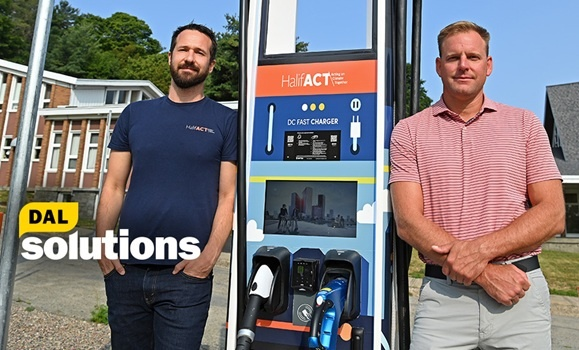THE SNAPSHOT
Dalhousie research is helping Halifax design a fast-charge electric vehicle (EV) network that's equitable, efficient, well used, and built to accelerate adoption, bringing real-world solutions to the heart of the city's energy transition.

Halifax's manager of clean energy Kevin Boutilier, left, and Dr. Lukas Swan stand by one of Halifax's new fast electric-vehicle chargers. (Daniel Abriel photos)
THE CHALLENGE: How much to charge for a charge?
In a parking lot overlooking the steady stream of traffic spinning around Halifax's Armdale Rotary sits one of the city's newest pieces of climate tech a Level 3 electric vehicle fast charger. One of six chargers recently installed as part of a network set to grow to 10 across the Halifax Regional Municipality (HRM), the 175-kilowatt charger stands in quiet contrast to the roar of engines and exhaling tailpipes circling the city's busiest roundabout.
Kevin Boutilier (BEng, 2013), manager of clean energy at the HRM, says the network of fast chargers offers equal parts utility and inspiration. The new units can charge a car from 20 to 80 per cent in just 10 to 20 minutes - far closer to the gas-station experience than earlier options.
The municipality is counting on the convenience of fast charging to help jump-start EV adoption. The goal is to attract more electric vehicles to Halifax roads with city-provided stations built with federal funding while paving the way for private companies to follow suit with their own.
"As the municipality, we aim to get the market moving. Eventually, we will be able to step back and let others take over," says Boutilier.
But to get the wheels of the project in motion, he needed to understand how to structure the pricing for the network in a way that optimizes its usage. And to help guide him, HRM City Council provided a clear mandate the network must cover its own operating costs.
THE SOLUTION: Solving an electric equation
Boutilier turned to Dalhousie energy engineer Dr. Lukas Swan, who had once been one of his professors at the university. Swan's research group had already investigated EV charging in Nova Scotia and established a key insight the optimal utilization rate for a fast charger is just 10 to 20 per cent or 3 to 4 hours per day.
"Anything higher, and drivers start to experience wait times that lead to frustration and reduced confidence," explains Dr. Swan. "Below that, and you're overbuilding capacity and won't cover costs. At 10 to 20 per cent, the public feels confident they can plug in when they need to, and that supports EV adoption."
Using this benchmark, Boutilier and his team arrived at the $45-per-hour rate currently charged across the HRM, which amounts to about $15 to $20 for a typical charge. With stations now in service, Boutilier saw an opportunity to add a greater level of sophistication to the pricing structure and turned again to Dr. Swan for a more nuanced model that reflects how EVs actually charge.
As batteries reach full capacity, the power flow slows fast at first but tapering off significantly when over 80 per cent charged. Despite this, the city's cost for electricity delivery doesn't vary. It's based in part on the highest power recorded at a charger during the month, regardless of the rate of delivery within a charge or subsequent charges.
"That'll happen when the first car comes through," says Dr. Swan, "And it doesn't make any difference how many more cars come after that first car in the month, that demand cost remains the same, and it's quite substantial."
Another reason to get people to move on when the charge slows goes back to the utilization sweet spot. If people hang around to fully charge their vehicle, they likely prevent the next car from using the station.
So, with support from a provincial grant, Boutilier partnered with Dr. Swan and his group members, including research engineer Dr. Nathaniel Pearre and student Niranjan Jayanath, to arrive at a new pricing model one that tracks more closely with actual energy costs and incentivizes drivers to move on once charging slows.
THE WORK: The ice cream factor
With a bit of jest, Dr. Swan says the price modelling was guided in part by a person's willingness to continue charging a nearly full car while they finish up an ice cream cone.
"If you're eating an ice cream, but your car is nearly done, you might just leave it there, if the added expense to use it is only a buck or two for the next 10 minutes," says Dr. Swan. "So, we came up with an incentive to disconnect and make way for the next person to start charging."
In the proposed system, pricing is based on the vehicle's "state of charge," data that's communicated between the EV and the station. Once a battery reaches around 80 per cent and charging begins to slow the cost rises significantly. If you really need the extra charge, you'll pay more for it. If you don't, you're more likely to move on and make room for the next EV.
The model also introduces greater fairness. Older EVs typically charge more slowly than newer models that can draw higher power. A flat hourly rate penalizes owners of slower-charging cars. The new model avoids this by scaling fees based on how much power is actually being delivered.
"Some cars charge at 175 kilowatts, others at 50 or less. We designed a fee structure that recognizes that difference," says Dr. Swan. "What we didn't want to do was come up with a tariff that said, Hey, everybody with a new car, you get a great deal. Everybody with an old car, not so much.'"
THE IMPACT: Powering policy with proof
Boutilier is now considering bringing the new model before HRM Council to update pricing. He says he's confident legislators would value Dal's research in advancing the model to better fit the needs of the municipality and consumers.
"There's a lot of trust in Dal," says Boutilier. "When we go to Council, when we talk to the public, being able to say this is evidence-based that it's backed by researchers at Dalhousie that carries real weight."
Dr. Swan says he and his team are pleased to be part of the evolution of the EV network in the HRM and the province, having played a role in its development by guiding evidence-based policy since the beginning.
"When we started on this 10-plus years ago, it was essentially all free because we wanted to incentivize people to get into EVs," says Dr. Swan. "But we're well beyond that point now, and so it's important that the costing structure is there and is equitably managed, especially considering the dramatic growth that is expected and is, in fact, occurring right now."













